November 2024 -- Turkish novelist Omer Faruk Alpdoğan began his next work, in which Nemrud Dagi will feature prominently; stay tuned for updates as he progresses.
April 6, 2023 -- Donald H. Sanders, president of Learning Sites has been interviewed by the Harvard Museums of Culture & Science for a podcast on the excavations of Theresa Goell atop Nermud Dagi, Türkiye (one of Learning Sites' first interactive virtual worlds). Related material can be found on the Museum's social media sites: LinkedIn, Facebook, Instagram, and Twitter.
March 31, 2023 -- The Harvard Museums of Science & Culture have gathered material about Theresa Goell's excavation of Nemrud Dagi into an online exhibition.
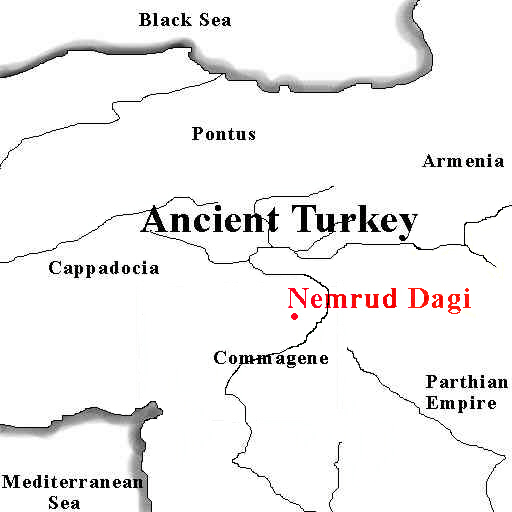 The sanctuary of Nemrud Dagi is one of the most remarkable, best preserved, but least known monuments
of Asia Minor. The site, called by its builder a hierothesion, or "common dwelling place of all the gods next to the heavenly thrones," is situated 2150m above sea level atop one of the highest peaks in the Anti-Taurus Mountains of southeastern Türkiye near the banks of the Euphrates River (see the map at the left; hover over to enlarge; and the GoogleEarth view below). The monument is one of the premier sites of the Late Hellenistic period. It was constructed by King Antiochus I of Commagene in the mid-1st century BCE to command a 360o view of the ranges, plains, and towns that comprised his ancient kingdom. It became the main sanctuary of his ruler cult to which worshippers from all over this kingdom were expected to go on the monthly and yearly anniversary of the king's birth and his accession to the throne.
The sanctuary of Nemrud Dagi is one of the most remarkable, best preserved, but least known monuments
of Asia Minor. The site, called by its builder a hierothesion, or "common dwelling place of all the gods next to the heavenly thrones," is situated 2150m above sea level atop one of the highest peaks in the Anti-Taurus Mountains of southeastern Türkiye near the banks of the Euphrates River (see the map at the left; hover over to enlarge; and the GoogleEarth view below). The monument is one of the premier sites of the Late Hellenistic period. It was constructed by King Antiochus I of Commagene in the mid-1st century BCE to command a 360o view of the ranges, plains, and towns that comprised his ancient kingdom. It became the main sanctuary of his ruler cult to which worshippers from all over this kingdom were expected to go on the monthly and yearly anniversary of the king's birth and his accession to the throne.
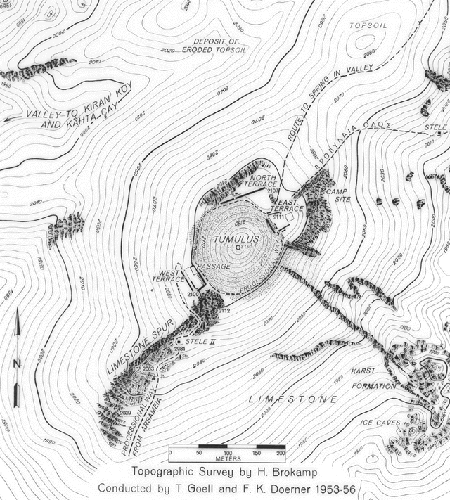 A Herculean effort by any standard, the construction of the site, covering more than 26,000square meters, involved carving three large terraces into the living rock of the mountain to flank its peak at the east, west, and north; the peak itself was covered with rubble chips to form a 50m-high tumulus. The plan of Nemrud Dagi (seen at the left; hover over to enlarge) was drawn in 1956 from the site survey by Heinrich Brokamp for the Theresa Goell excavations.
A Herculean effort by any standard, the construction of the site, covering more than 26,000square meters, involved carving three large terraces into the living rock of the mountain to flank its peak at the east, west, and north; the peak itself was covered with rubble chips to form a 50m-high tumulus. The plan of Nemrud Dagi (seen at the left; hover over to enlarge) was drawn in 1956 from the site survey by Heinrich Brokamp for the Theresa Goell excavations.
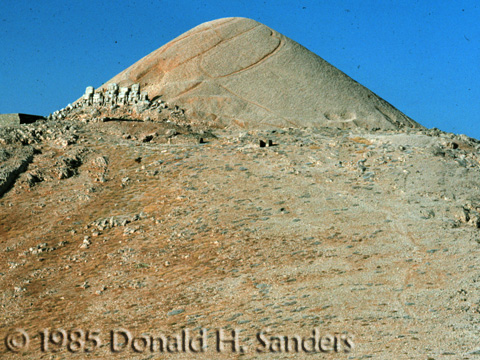 View up to the East Terrace from one of the processional ways leading to the site laid out by King Antiochus (image courtesy of Donald H. Sanders; hover over to enlarge).
View up to the East Terrace from one of the processional ways leading to the site laid out by King Antiochus (image courtesy of Donald H. Sanders; hover over to enlarge).
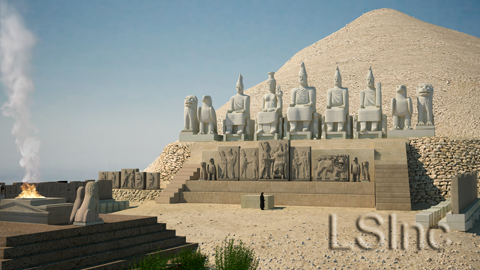 The East and West Terraces together contain an astonishing array of sculpture, inscriptions, and architectural elements (a rendering from our 3D model at the left shows the East Terrace; hover over to enlarge). Each terrace bears a set of five colossal seated figures (8-9m high) of King Antiochus and his Greco-Persian tutelary deities. In addition, there are dozens of reliefs with over-lifesize figures portraying Antiochus' glorious maternal and paternal ancestors garbed in authentic period costume; each stela bears an inscription on its back that identifies the figure on the front. Investiture reliefs, scenes depicting Antiochus being greeted individually by each member of his pantheon, and the earliest known calendrical horoscope also appear. Numerous statues of lions and eagles guard the site's features, and altars are profuse.
The East and West Terraces together contain an astonishing array of sculpture, inscriptions, and architectural elements (a rendering from our 3D model at the left shows the East Terrace; hover over to enlarge). Each terrace bears a set of five colossal seated figures (8-9m high) of King Antiochus and his Greco-Persian tutelary deities. In addition, there are dozens of reliefs with over-lifesize figures portraying Antiochus' glorious maternal and paternal ancestors garbed in authentic period costume; each stela bears an inscription on its back that identifies the figure on the front. Investiture reliefs, scenes depicting Antiochus being greeted individually by each member of his pantheon, and the earliest known calendrical horoscope also appear. Numerous statues of lions and eagles guard the site's features, and altars are profuse.
The ensemble was carefully linked to the townspeople in the surrounding countryside
by three processional ways, one leading up to each terrace. Each pathway was guarded by an advisory maker warning visitors to only have pious intentions or be struck down by the thousand arrows of Apollo and Heracles. Nemrud Dagi is truly a remarkable testimony to the skills of King Antiochus and his historians and artisans.
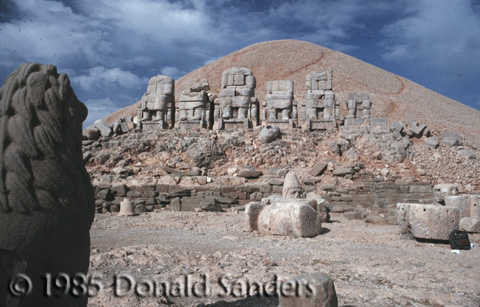 The monument was first discovered for Western eyes in the late 19th century. It had always been known to the local population, who revered the site as the legendary home of their ancient kings. After a series of seemingly fantastic reports by 19th-c. German explorers (telling of giant statues, 100s of relief sculptures, and immense animals), incredulous authorities sent a team to Türkiye to climb Nemrud Dagi. At the same time, the Turks sent an investigative contingent (view from the East Terrace fire altar toward the great podium at the left; photo courtesy of Donald H. Sanders; hover over to enlarge; compare with the rendering above, taken from the same vantage point). Each group set out to upstage the other; neither group spent more than a couple of weeks recording the visible remains as best they could in up to 4m of snow, howling winds, and with minimal equipment. The two reports made by the two 19th-century teams, valuable as they are for detailed accounts of the site's sculpture and inscriptions, are incomplete and inaccurate; yet the two publications became the accepted foundation upon which numerous art historical, genealogical, and religious interpretations and extrapolations have been based. As a result, a false and biased view of the king, his sculpture, his lineage, his reign, and his political proclivities has pervaded Late Hellenistic scholarship to this day.
The monument was first discovered for Western eyes in the late 19th century. It had always been known to the local population, who revered the site as the legendary home of their ancient kings. After a series of seemingly fantastic reports by 19th-c. German explorers (telling of giant statues, 100s of relief sculptures, and immense animals), incredulous authorities sent a team to Türkiye to climb Nemrud Dagi. At the same time, the Turks sent an investigative contingent (view from the East Terrace fire altar toward the great podium at the left; photo courtesy of Donald H. Sanders; hover over to enlarge; compare with the rendering above, taken from the same vantage point). Each group set out to upstage the other; neither group spent more than a couple of weeks recording the visible remains as best they could in up to 4m of snow, howling winds, and with minimal equipment. The two reports made by the two 19th-century teams, valuable as they are for detailed accounts of the site's sculpture and inscriptions, are incomplete and inaccurate; yet the two publications became the accepted foundation upon which numerous art historical, genealogical, and religious interpretations and extrapolations have been based. As a result, a false and biased view of the king, his sculpture, his lineage, his reign, and his political proclivities has pervaded Late Hellenistic scholarship to this day.
The site of Nemrud Dagi remained an enigmatic and distant curiosity until the
excavations of American archaeologist Theresa Goell (the first Western woman to penetrate this far into Kurdish Türkiye) and her international team of collaborators exposed the entire site in the 1950s. Her efforts to reveal the true nature of Antiochus' architectural and sculptural programs continued into the 1960s with the pioneering use of many geophysical exploration techniques. Miss Goell died in 1985, leaving her final analyses and excavation report unfinished. After many decades of research, a full publication of Nemrud Dagi has emerged, coordinated by archaeologist Donald H. Sanders, with the assistance of many from Goell's original team of investigators.
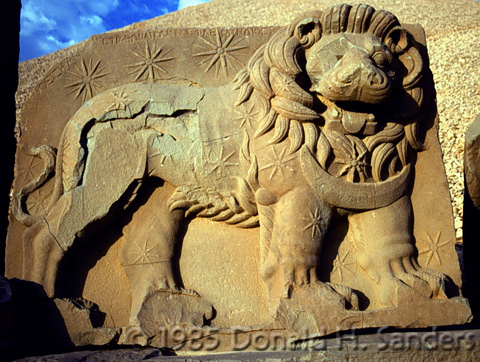
The inscriptions on the back of the ancestor stelae provide conclusive evidence, available nowhere else in the ancient world, for the sequence of Seleucid, Macedonian, and Persian rulers back to Alexander the Great and Darius I, making the stelae on Nemrud Dagi crucial historical documents.
Evidence exists here for demonstrating for the first time that Alexander was called "the Great" already in antiquity.
The fusion of Greek and Persian deities and religious rituals at Nemrud Dagi, evident in the sculptural iconography and the inscriptions, provides stunning evidence of the extent to which the Mithraic religion had moved from the Near East toward Europe, marking here in Commagene the crucial crossing from East to West of this popular counterthrust to the emergence of Christianity.
The attention Antiochus' craftsmen paid to precise historical details of regalia on the figures depicting rulers hundreds of years earlier than the Hellenistic age is unprecedented.
Online Resources
Dall, Amelia
2021 Instagram post: Nemrud Dagi: an incredible archaeological site in Turkey Middle East Technical University (Ankara, Türkiye) has prepared the official Nemrud Dagi Conservation Program Website under the guidance and support of the Turkish Ministry of Culture and Tourism and with information and images provided by Learning Sites. Bibliography
Goell, Theresa
1957 "The Excavation of the Hierothesion of Antiochus I of Commagene on Nemrud Dagh (1953-1956)," Bulletin of the American Schools of Oriental Research 147:4-22. 1952 "Nimrud Dagh: The Tomb of Antiochus I, King of Commagene." Archaeology 5.3:136-144. Hamdy, Osman Bey & Osgan Effendi
Humann, Karl & Otto Puchstein
Sanders, Donald H.
Sanders, Donald H. & David W. J. Gill.
2021 YouTube video: Deaf Heroine in Archaeology: Theresa B. Goell
1961 "Throne above the Euphrates," National Geographic 119:390-405.
1883 Le tumulus de Nemroud-Dagh: voyages, description, inscriptions. Constantinople: Pera, Loeffler.
1890 Reisen in Kleinasien und Nordsyrien. 2 vols. Berlin: Reimer.
1996 Nemrud Dagi: The Hierothesion of Antiochus I of Commagene: results of the American excavations directed by Theresa B. Goell. 2 vols. Winona Lake, IN: Eisenbrauns. (This report can be obtained directly from the publisher.)
2004 "Theresa B. Goell," pp.482-524 in Getzel M. Cohen and Martha Sharp Joukowsky, eds., Breaking Ground: pioneering women archaeologists, Ann Arbor MI: The University of Michigan Press.